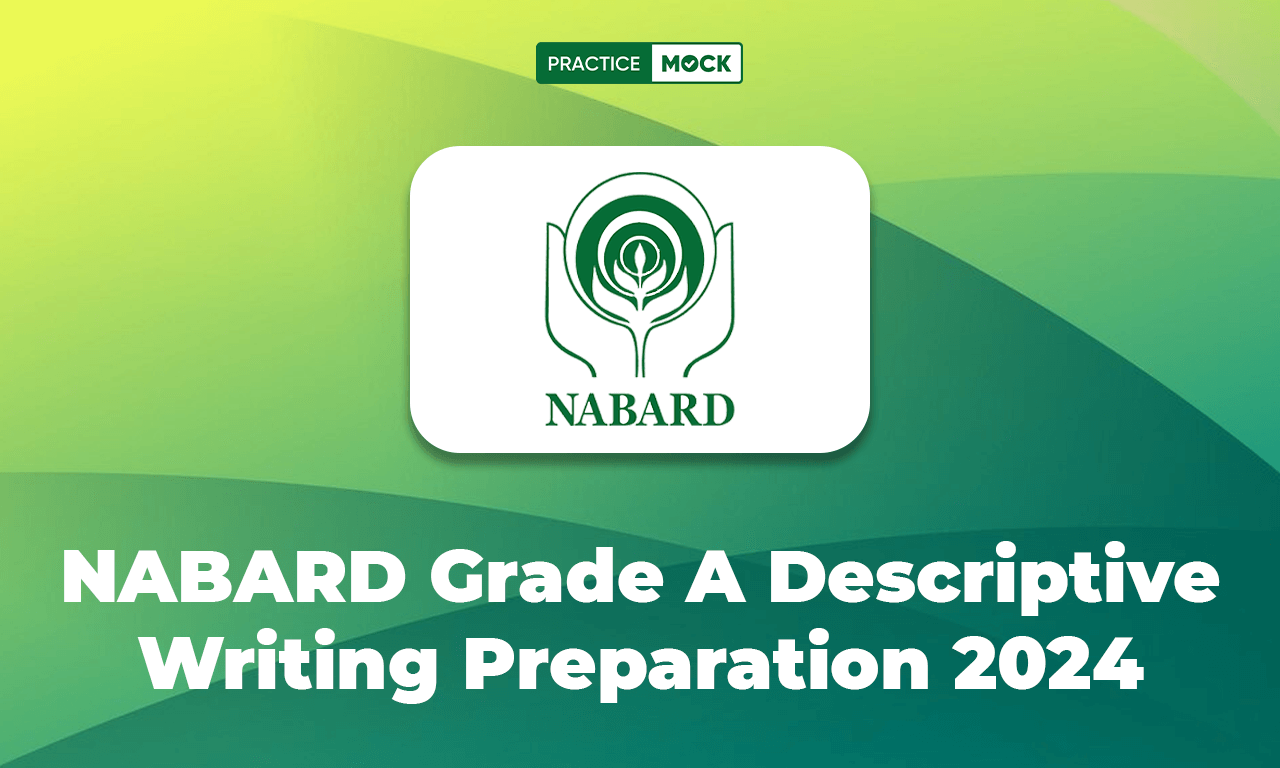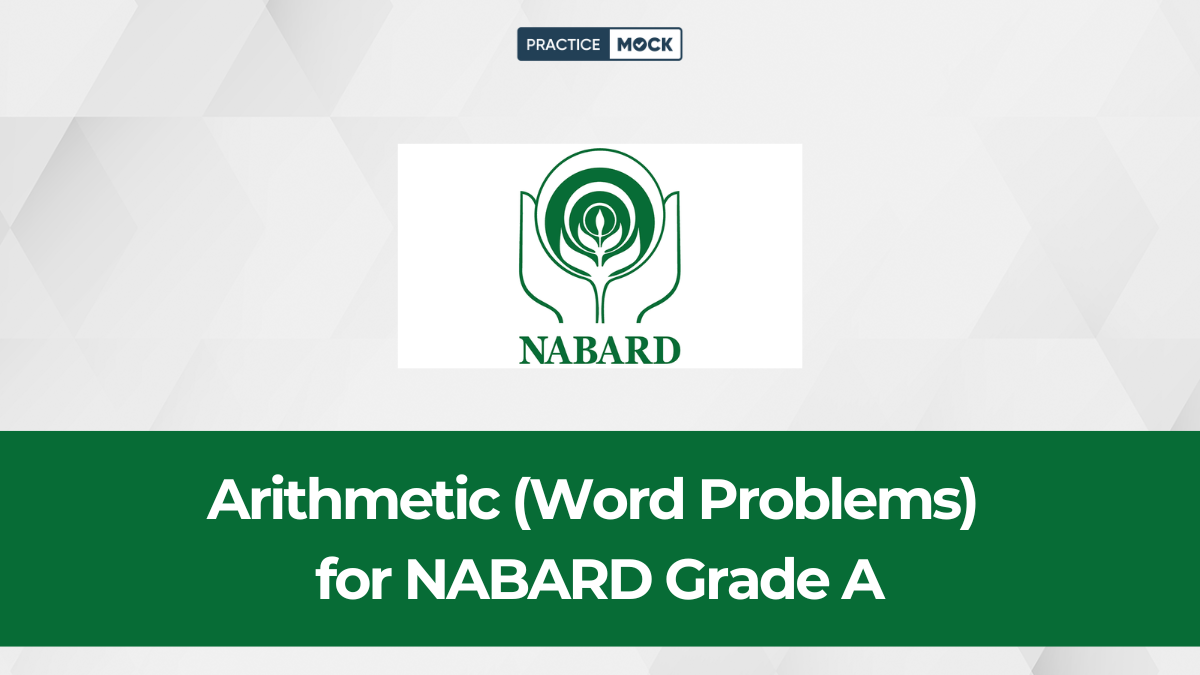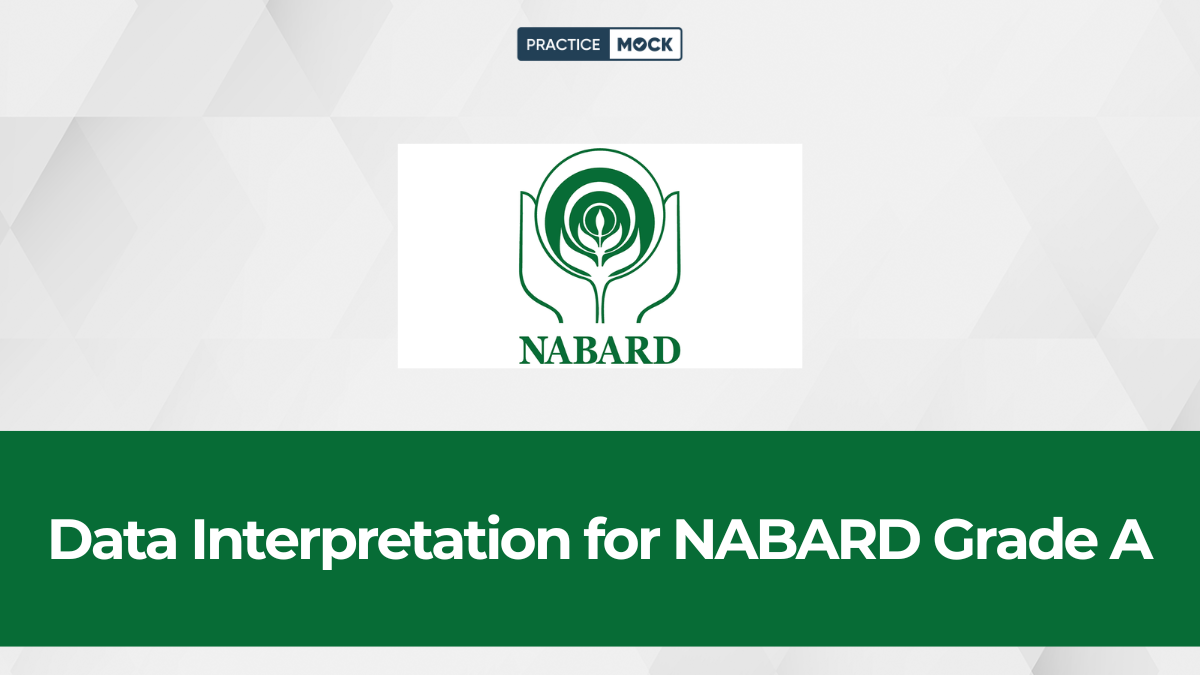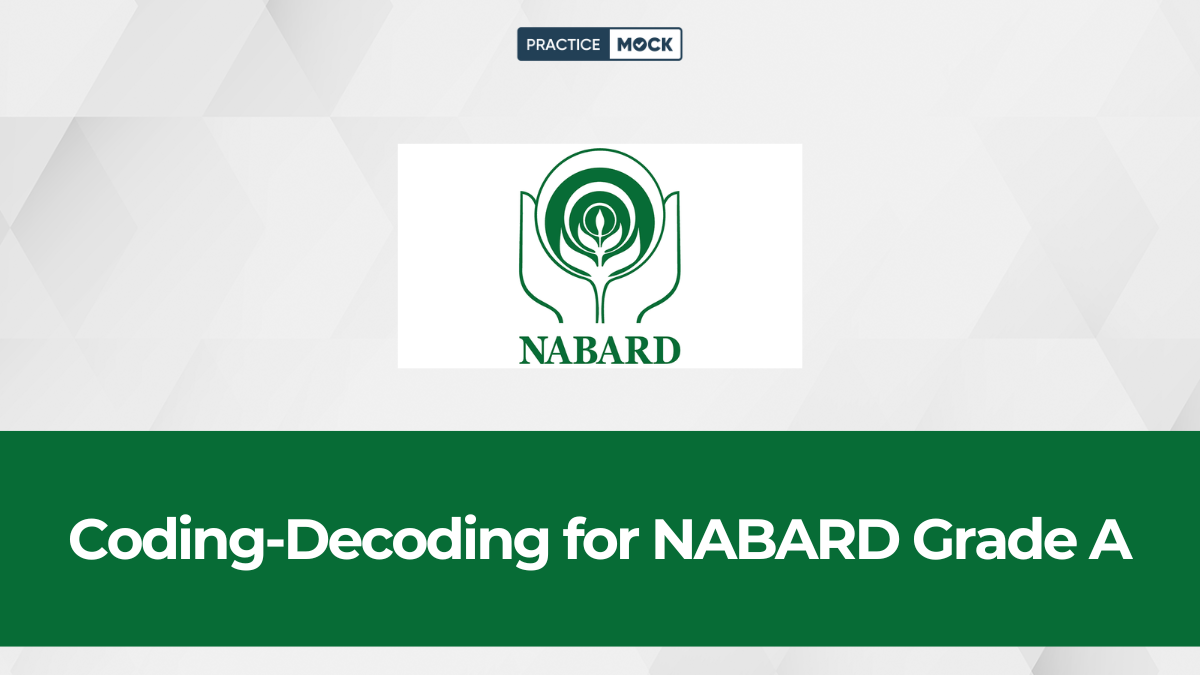NABARD Grade A Descriptive Writing Preparation 2025, Best Practice


Have you taken the NABARD GRADE A Phase 1 exam? Now sitting back and relaxing? It’s not time to relax yet because the Phase 2 exam is also coming, and descriptive English is a very important part of it. Online descriptive English is a part of General English, where 3 questions will be asked. These 3 questions will carry a total of 100 marks, and candidates will have to answer them within 90 minutes. You will need to type the descriptive answers using the keyboard. Therefore, preparing well for the descriptive paper is extremely necessary. This paper can increase your overall score. In this blog, we will discuss all the tips that can help you score the maximum marks in this section.
NABARD Grade A Descriptive Writing Preparation Strategy
Let’s take a deep dive into all the parts of the NABARD Grade A Descriptive Writing and know how to counter it successfully in the upcoming exam:
NABARD Grade A Mains Exam Pattern
NABARD Grade A Mains Examination, also known as Phase II, will be conducted online and will be a mix of MCQ and descriptive patterns.
| NABARD Grade A 2025 Phase 2 Exam Pattern | ||||||
| Paper | Subject | Type of Paper | No. of Questions | Marks | Duration | Remarks |
| Paper 1 | General English | Online Descriptive | 3 | 100 | 90 Minutes | Evaluates writing, analytical, and drafting skills through- : Essay (40 marks), Comprehension (20 marks) : Precis (20 marks) : Report/Para/Letter Writing (20 marks). Answers are to be typed using a keyboard. |
| Paper 2 | Economic & Social Issues, Agriculture & Rural Development | Objective + Descriptive (2 parts) | Objective: 30 | Objective: 50 | Objective: 30 minutes | Descriptive answers can be typed in English or Hindi (Remington/Inscript keyboards). |
NABARD Grade A Descriptive Writing 2025 – Topic Wise Preparation Tips
Let’s talk about the art of essay writing first.
1. Essay
An essay is a piece of writing that is penned on a given topic. It is usually divided into three important parts, known as its structure. They are: Introduction, Body, and Conclusion. In a good essay, there should be no grammar or other mistakes. The ideas should be well connected and should gel together.
Introduction of The Essay:
- Start by introducing the given topic. It should have opening lines that catch the attention of the reader. You can even begin the discussion with a quote concerning the topic.
- Ensure that a shift from one idea to another more relevant one is done in the introduction part which is about the topic to be discussed.
- It should offer the reader an idea of what they are to expect in terms of the layout of the essay In a logical sequence.
- To be precise, the thesis statement often seems to be the most important part of an introduction, and the last one must always be the main argument.
- The thesis statement or the main idea of the essay lets the reader know what the writer is planning to achieve in the essay and may reveal cases a writer is going to use.
Body of The Essay:
- It includes your views on the given topic in detail. It consists of parts of the evidence and the support for the essay with some added value from the author. The body of your essay should have 3 to 4 paragraphs.
- Every paragraph must also include an initial statement that relates to the main argument.
- Ensure that there are transitional/connected sentences in the essay so that it has an easy flow.
- Support your statements with vigorous real-life examples and make sure you have cited anything you’ve read or researched.
- Every example given should relate to the given topic of discussion.
- It should be well thought out and organized. Here are 3 common types:
Here are 3 common types:
- Chronological order: very suitable for stories as functions in line with time sequence.
- Spatial Order: useful for outlining the field, putting forward a concept movement from top to bottom.
- Emphatic Order: from the least important to the most important, which is the most suitable for college writing.
6. Stay within the word limit.
Conclusion of The Essay:
- This part should summarise all the ideas or arguments made in this writing.
- It should provide the summary of the main points of the paper in clearer to understand manner.
- Always make sure that you leave the reader with something to think over.
- Avoid introducing a new idea in it.
- Avoid using the same words or vocabulary that you used in the body of the essay.
Still, don’t forget that you always have some time left for revision of the first draft and for proofreading it.
NOTE: You need to plan your essay before starting to write it. Don’t just start writing without thinking. Keep this rule in mind: If you are given 10 minutes for the essay, take 6 minutes to write it and 1 minute to revise or edit your essay.
2. Precis
Precis is a summary or concise or abridged statement of a given passage. It contains all the important points, mood, and author’s tone, and the main idea of the given passage. It is also important to abide by the word limit. So, candidates must practice them by typing 3-4 or more precis daily.
Here a 5 steps to write a précis:
| Step | Action |
| Step 1 | Read the passage carefully and highlight important points and keywords in order as in the original passage. |
| Step 2 | Note down the main idea and author’s tone. |
| Step 3 | Re-read the passage, compare it with notes, and check for missed information. |
| Step 4 | Provide the most suitable title. |
| Step 5 | Draft précis using your notes. |
3. Reading Comprehension
Reading Comprehension is the ability to understand the given text. It tests a candidate’s reading and comprehension skills, along with his/her knowledge of words and overall language through context.
Here are the tips to master reading comprehension:
| Skill Area | Tips for Improvement |
| Reading Comprehension | It tests you on how well you understand the given text, including your knowledge of words and your understanding of the context or meaning of the text. |
| Steps to Master RC: | 1. Increase your reading speed for better performance. 2. Build your vocabulary power by learning new words daily. 3. Learn and use idioms and phrases in regular conversations with friends and family. 4. Read content related to and on Agriculture, Rural Development, and the Economy. |
4. Business/Office Correspondence
Writing for business or office correspondence includes drafting memos, emails, and letters. Each of these has a different length, format, tone, and purpose. Let’s delve into each type to better understand and master the art of writing all three forms of business communication.
I. Memos
A memo is a short note or memorandum. A Memo must have a subject line, an introduction, a discussion, and a conclusion. Memos have a simple and informal language with a friendly tone. Try to make the subject line as catchy as possible as readers don’t ignore it. It should also contain the purpose of writing it and clearly express the expectations for which it has been written. It should have questions like who, how, why, and when. Its conclusion should have a compliment and must ask the readers to take action compellingly.
II. Emails
The advent of email has made business processes easy. You need to master the art of writing Emails in the exam by following the points given below:
- Understand your audience well
- Identify yourself to your audience
- Use the official or identifiable email IDs
- Write a simple, concise, and effective subject line
- Keep your message brief and well-structured
- Highlight the points where necessary
- Carefully Proofread after writing it before sending it
III. Letters
A letter is written communication, more formal than a note. In business communication, there are multiple types of letters. They are News, complaints, sales, adjustments, inquiries, and covers. Check out the table below to learn about a few necessary components that business letters should contain:
| Type | Description | Essential Components | Optional Components (depends on the Letter Type) | Example |
| Letters | Formal written communication | Address of writer, Date, Address of recipient, Salutation, Body, Complimentary close, Signature | Subject line, Enclosures, Writer’s initials, Copy notation | “Dear Sir, Thank you for…” |
| Types | News, Complaints, Sales, Adjustments, Inquiries, Cover | News: “We are pleased to inform…” Complaints: “I am writing to report…” Sales: “We are excited to offer…” Adjustments: “We regret the error and will…” Inquiries: “Could you provide details about…” Cover: “Attached is my resume for…” |
Nabard Grade a Study material
Having the right study material is very important. Preparing for NABARD Grade A might get overwhelming at times. The right resource helps in dividing the huge syllabus into phases make studying easier. We’ve at PracticeMock provide full-length mock tests, section-wise quizzes and what not. Find the link below and start your preparation now.
What to Do Now?
Don’t forget that continuous practice is the only route to success in the descriptive part of the Phase 2 exam. Especially, if you want to score 85+ Marks in it. The above description might have given you an idea about how to approach each part of the descriptive English section. Start your practice today by signing up for the latest NABARD Grade A Phase 2 mock tests, learn from the feedback, improve, and check your improvement by taking another mock test. keep doing it until you’re confident of your success.
| Related Blogs: | |
| NABARD Grade A Exam Date | NABARD Grade A Cut Off |
| NABARD Grade A Syllabus | NABARD Grade A Vacancy |
| NABARD Grade A Salary | NABARD Grade A Preparation Strategy |
| NABARD Grade A Study Plan | |
FAQs
Check out the blog above to learn all the important insights needed to master this important part of the exam.
You can get the direct link to attempt NABARD Grade A Phase 2 Mock Test and know your AIR from the blog above.
Recent Posts
RRB Clerk Quantitative Aptitude Master Strategy: Check tips to Score 35+ Marks in Real Exam
In this article we are providing the RRB Clerk Quantitative Aptitude Master Strategy 2025, candidate…
200+ Number Series Repeated Questions For RRB PO Based on Previous Year Paper
In this article, we are providing the 200+ Number Series Questions for RRB PO based…
RBI Grade B Notification 2025, Expected Release Date & Latest Updates
Get all the information you need about RBI Grade B 2025 Notification, including Exam Date,…
RBI Grade B Selection Rate- Check Success Rate, Percentage and Ratio
Learn about RBI Grade B’s selection rate, applicant statistics, and how to plan smarter with…
BOB Office Assistant Cut-off 2025
BOB Office Assistant cut-off is given with the previous year trend analysis, and the expected…
Success Story of Shreyash Sharma, Cleared Supreme Court JCA
In an interview with PracticeMock, Shreyash Sharma shared his journey of clearing the Supreme Court…



